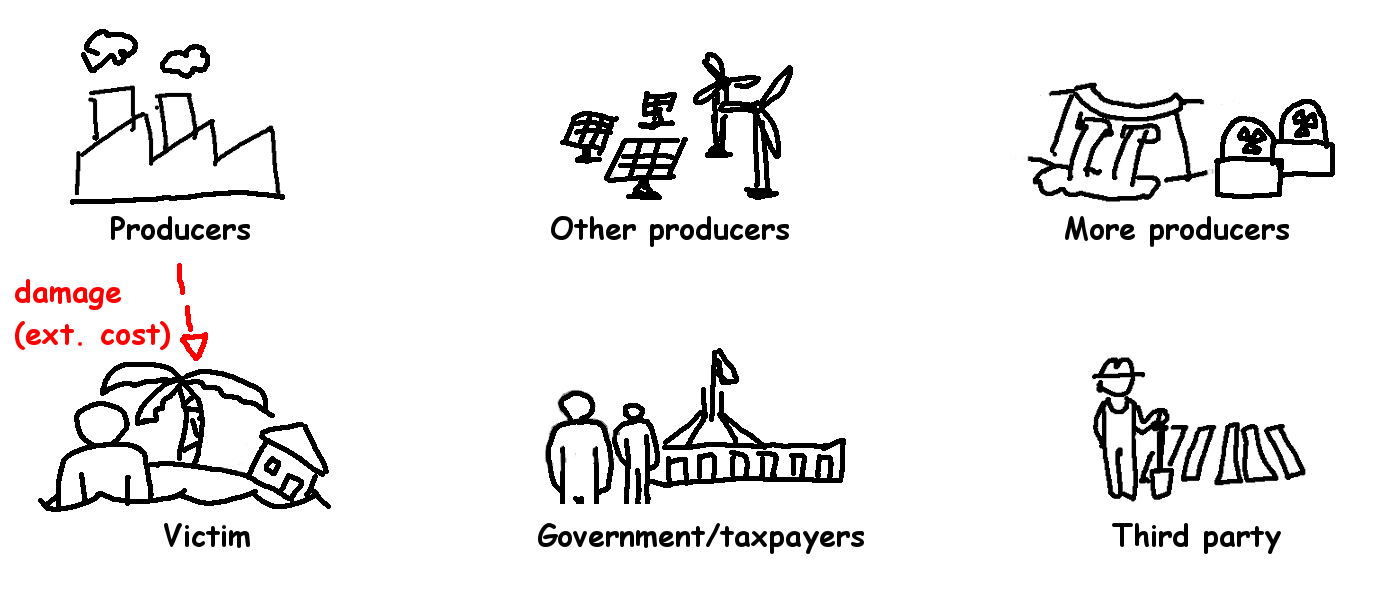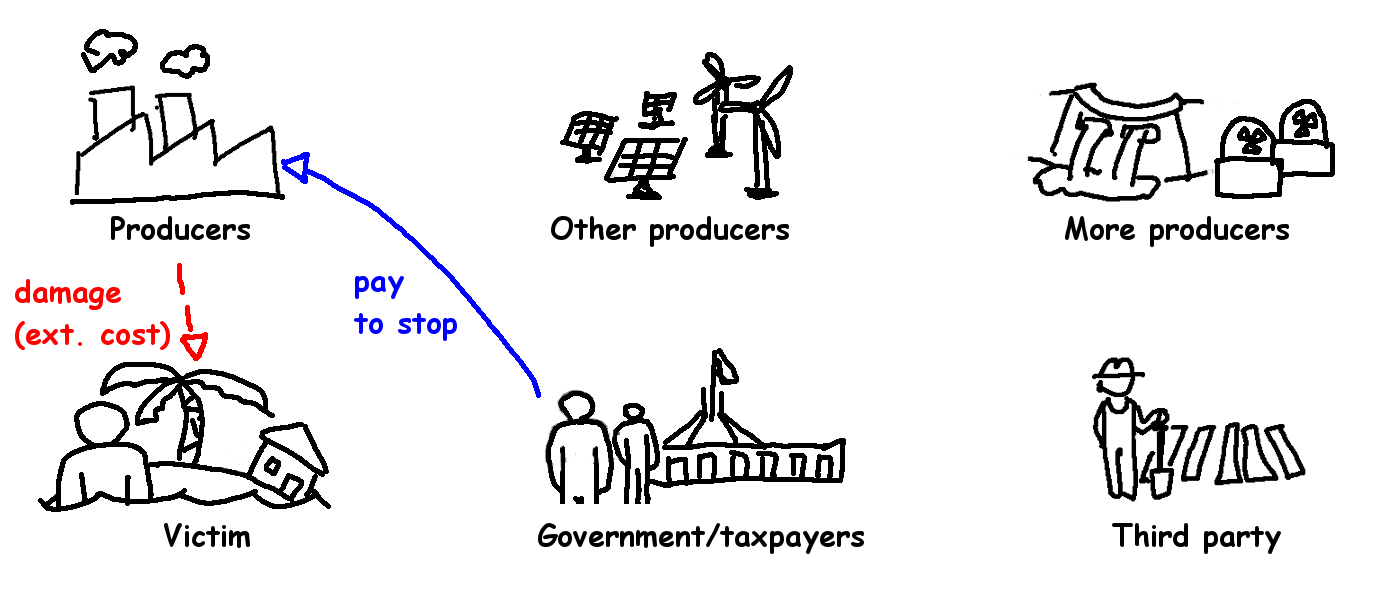There are two interrelated aspects when discussing global warming and climate change: one is the validity of the science, and the other is the policy approach taken.
This post is about the policy approach taken, so rather than debate the science, assume there is a scenario where a producer is causing damage (external costs) to others, and consider what policy is appropriate in such a situation:

For too long has the Left been allowed to own this issue, leading invariably to big government attempts at a solution. Given the track record of governments in handling environmental issues, this is not a good outcome.
Most current policy approaches to this situation are wrong because they are manifestly unfair.
It is time that we campaign to ensure that a fair, market-based, solution is achieved.
Below I will detail several of the current policy approaches being used, and show why they are wrong; I will then make the case why the libertarian approach, based on private property rights, is the correct solution.
Some of the wrong policy solutions currently being used:
1) Government pays for adaption and mitigation

The government can provide money (taken from taxpayers) to the victim, to help with mitigation and adaption costs. This will compensate the victim for their loss, but does nothing to stop the bad producer from continuing to cause damage.
This is unfair on taxpayers, while the bad producers benefit unfairly from their continued windfall.
2) Make the bad producer subsidise some good producers

There are many ways such subsidies can be implemented.
For example, rather than direct subsidies (the government taking from bad producers and/or giving to good producers), via regulations you could require a minimum percentage of the wholesale market to be forced to be purchased from 'good' producers, the Renewable Energy Target (RET).
This transfers sales (income) from bad producers to the good producers, and has basically the same effect as a subsidy. Whilst this will reduce the amount of damage done (as the bad producers will be producing less, as their effective price is higher and the subsidised producers lower), it does nothing to compensate the victim.
The situation is even worse where the regulations only specify particular producers or particular types of producers, whilst others are ignored, or even banned completely.
This is unfair for the victim, while generating an unfair windfall for certain producers (often those who the legislator gets donations from) but not others.
3) Arbitrary large tax on bad producers

Such a tax could either be a direct tax, or even some kind of market-based permit system (cap and trade). The effect would be to generate revenue for the government from bad producers. With an arbitrary rate, or an arbitrarily set permit level, the size of the tax is not at all related to the cost of the damage done,.
This would reduce the amount of damage done (as the relative price of bad producers goes up and they produce less), however it does nothing to compensate victims.
There are also problems arising from the mismatch in size; if the size of the tax is much larger than the cost of the damage done, it can could lead to under compensation - you might save the houses of 100 people from rising sea levels, but in return condemn 1,000 people to miss out on the benefits of energy.
An arbitrary tax is not only unfair to victims, and could cause more damage than it saves, but I find it perverse that the result of the suffering of the victim is that the government gets a taxation windfall.
4) Pay bad producers to stop

Despite how bad the other solutions are, this one is even worse. Why a solution such as Direct Action would ever even be considered is simply beyond me.
Sure, in theory if you paid enough it could reduce the damage done, but it is pretty much the most unfair solution you can devise, having things completely around the wrong way, providing a massive incentive for the bad producer - literally rewarding them for having caused damage.
5) Do nothing, aka cost benefit analysis

Some argue that the policy approach should be to do nothing, that because the benefits of the producer's activity are more than the costs there is no need to intervene; they may even bring up the existence of additional external benefits to third parties, such as increasing crop yields in some areas, as further justification to do nothing.
However, while a cost-benefit analysis can be important to determine if the activity is worth continuing, it does not negate the obligation to compensate the victim.
Ed Dolan makes this point quite well in "TANSTAAFL (There Aint' No Such Thing As A Free Lunch) - A Libertarian Perspective on Environmental Policy", first published in 1971, but updated in 2011:
Suppose you were caught shoplifting a magnum of Veuve Clicquot from your local wine merchant. Would you expect to be able to use a cost-benefit defense in court? Would you expect it to be enough to show that you valued the bottle at $75, perhaps by showing that you had paid that much for similar bottles inthe past, while showing that the merchant's loss was only the $50 wholesale price paid when the wine was placed in stock? I doubt if most judges would be favourably impressed. They would say that demonstrating your williness to pay is not enough. If you don't actually make the payment, you are a common thief, no matter how refined your palate for champagne.
In short, the solution of doing nothing is still unfair for the victim.
The correct policy approach
So, what is the correct policy approach then? Well, it is for the victim to be paid compensation for adaption and mitigation costs, similar to the first policy, except that instead of being paid for by the taxpayer, the costs should be paid by the producers causing the damage.

This solution is based on tort law and strong protection of private property rights, where the victim should be allowed to sue the producer for the damage done to their property. For an introduction to this approach, see "The Libertarian Manifesto on Pollution" by Murray Rothbard [http://mises.org/daily/5978/] - note that although CO2 may not necessarily be considered a pollutant, the same approach can be applied to any damage / external cost.
Party policy
This policy approach (to pay for any external costs, once damaged has been proven caused by a producer) is one of the points from the current (2016) Liberal Democrats energy policy [http://ldp.org.au/policy/energy/]:
The Liberal Democratic Party (LDP) believes:
- The price of energy must take account of its ‘whole of life’ costs and should not transfer any costs to others through any means other than price.
This also implies opposition to the other (wrong) approaches above:
- oppose subsidies between energy suppliers and the Renewable Energy Target
- also remove bans on alternative sources of energy, such as nuclear
- oppose an arbitrary carbon tax
- oppose Direct Action and taxpayers rewarding bad producers
I don't know of any other Australian political parties that have a policy on climate change that supports 'whole of life' costs.
Determining damages to be paid
In general tort law, if the likely damage is known in advance, it is usually silly to wait until after the damage has occurred and then go through the court system. Obviously if damage in unexpected, then it can only be processed after the fact, although then it will often also include punitive damages (pain and suffering) and legal costs.
A far more effective approach, where likely costs are known, is to settle out of court, or even negotiate (arbitrate) before any damage is even done, to put into place any adaption or mitigation measures (paid for by the bad producer), which are often a cheaper solution, or even simply come to an agreement on the amount of compensation to be paid.
In some cases, where the outcome is uncertain, it may even be worth the producer settling out of court with no admission of liability, paying some agreed amount simply to avoid the costs of a trial.
Note that it is also not much of an issue how the payments are made - the producer causing the damage can pay directly, but a garnishee on their earnings (taken by the government, and given to the victim) is just as acceptable.
One such implementation could be a Pigouvian tax or levy; provided it is matched to the costs of damages, and paid to the victims, it satisfies the policy criteria. In this case the money does go through the government (who manages both the tax and the compensation), but as the amounts are equal it neither benefits nor costs the taxpayer.
We already have a good idea of what damage will be done by climate change and where, and have already negotiated several agreements for adaption and mitigation (Australia currently pays around $500 million per year). The only problem is that these are being paid by general taxpayers (as the first example policy), and not by the producers.
Finally, when considering whether you think sufficient evidence exists to, based on the policy approach, actually start making payments (and ignoring the fact that negotiations have already occurred and we already are making payments), it is important to note that the usual level of evidence required for tort is "on the balance of probabilities", not the more strict criminal requirement of "beyond reasonable doubt".
So ask yourself, on "on the balance of probabilities", is there enough evidence that producers should be paying for the adaption and mitigation costs of those affected by climate change?
